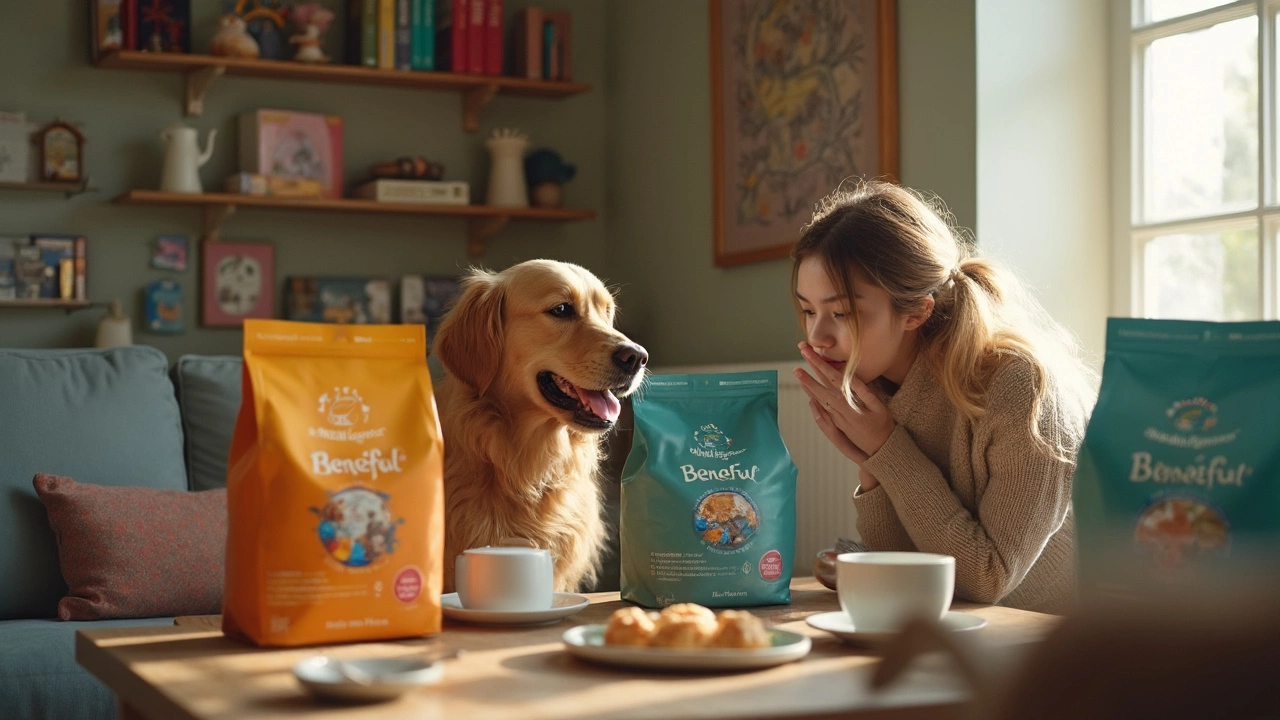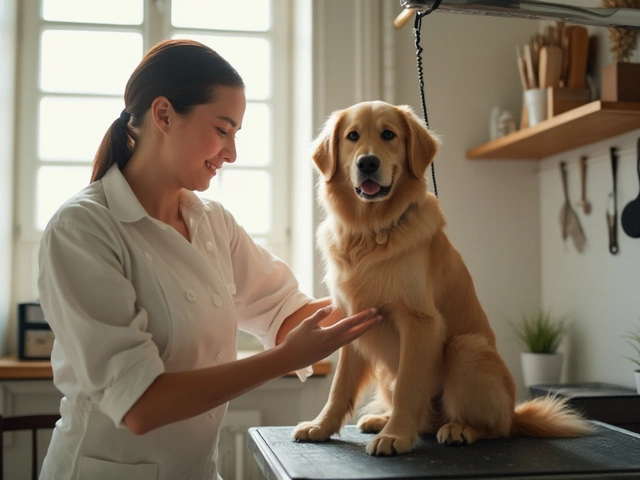If you’ve ever walked down the pet food aisle, you’ve seen those bright Beneful bags staring you down. It’s one of the best-selling dog food brands out there, but does that actually mean it's good for your dog? If you find yourself staring at the label, scratching your head, and wondering if you’re doing your pup a favor or just falling for clever marketing, you’re not alone.
Many dog owners feel a bit lost when picking food, especially with all the opinions flying around online. My own dog Rufus isn’t shy about letting me know if something upsets his stomach or leaves him hungry an hour later—so trust me, I’ve spent my fair share of time reading ingredient lists. Sometimes what jumps out is the fine print: what’s actually inside, and what does it all mean for your dog?
This isn’t just about whether Beneful fills a dog’s bowl—it’s about how it might affect their health over the long haul. We're breaking down what’s really in those kibble pieces, what some people worry about, and how you can make the right choice for your best furry friend. Let’s get into the nitty-gritty and make sense of what your dog is actually eating.
- What's in Beneful Anyway?
- The Benefits and Red Flags
- What Vets and Dog Owners Are Really Saying
- Picking the Right Food for Your Dog
- If You Decide to Try Beneful
What's in Beneful Anyway?
When you flip over a bag of Beneful dog food, the first thing you'll see is a long list of ingredients. It’s easy to get lost in all the names, so let's break down what’s actually inside. The first ingredient in most Beneful dry foods is chicken, beef, or salmon—sounds good, right? Protein is the big star because dogs need it to stay strong and healthy.
But here's where things get tricky. Right after the meat, you’ll notice grains like corn, wheat, and barley. Some formulas even list corn as the first or second ingredient. Corn and wheat are used as fillers and for energy, but not every dog needs them. If your dog has allergies, these might be an issue.
Then there are those unpronounceable names: things like "animal digest" or "propylene glycol." Animal digest is basically a flavor enhancer, while propylene glycol helps keep kibble chewy. The FDA says these are technically safe, but some dog owners would rather avoid them. You’ll also spot colors like Red 40 or Yellow 6—they’re just to make the food look better to you, not your pup.
Want to see what’s in a typical bag? Here’s a real snapshot for Beneful Originals with Real Beef:
| Top 5 Ingredients |
|---|
| Ground Yellow Corn |
| Chicken By-Product Meal |
| Corn Gluten Meal |
| Whole Wheat Flour |
| Animal Fat (preserved with mixed-tocopherols) |
Something else worth mentioning: unlike some premium brands, Beneful usually includes by-products (like organ meats) instead of just whole cuts of meat. It’s not all bad—dogs can actually get nutrients from these parts, but if you want only the best cuts, you’ll want to look for foods that make that clear on the label.
Don’t forget the added vitamins and minerals tucked in at the end of the ingredient list. These keep your dog’s coat shiny, their immune system strong, and their tails wagging. Still, if your dog has food sensitivities or needs a grain-free diet, Beneful’s ingredients might not be the perfect match.
The Benefits and Red Flags
Alright, let’s get real about Beneful dog food. It’s affordable and everywhere, which makes life easier when you’re shopping for your dog’s dinner. Plus, some of their flavors actually smell okay for dry dog food—which is more than I can say for a few other brands Rufus has turned his nose up at.
Now let’s talk perks. Since Beneful is made by Purina, you know it goes through basic quality checks. Most of their recipes list meat or poultry as a top ingredient, and they often add vitamins, minerals, and things like omega fatty acids for shiny coats. They also offer grain-free options for dogs with sensitive stomachs, which is handy.
- Lots of recipe choices for picky eaters
- Affordable compared to other big brands
- Available at most grocery stores
- Recipes fortified with vitamins and minerals
But here’s the stuff that makes some owners pause. Read the label and you’ll see "chicken by-product meal" and "corn gluten meal" popping up often. That just means they use parts of animals most people wouldn’t eat, along with grains as fillers. Some folks are totally fine with this, but others prefer whole meat and fewer fillers.
There’s also noise online about dogs getting sick from Beneful. Purina points out that their food meets FDA and AAFCO standards, and actual recalls are super rare (the last big one was way back in 2016, and not for anything life-threatening). Still, some veterinarians recommend checking if your dog is allergic to any food dyes or grains, since Beneful uses artificial colors in many recipes.
| Ingredient | Potential Issue |
|---|---|
| Corn | Can be hard to digest for some dogs |
| Chicken by-product meal | Not whole meat, though still provides protein |
| Artificial colors | May trigger allergies in sensitive dogs |
If your dog doesn’t have food allergies and you’re on a budget, Beneful could work just fine. But if you’ve got a sensitive pup or want something with fewer fillers and artificial dyes, it might be worth looking at other options. Remember to keep an eye on your dog after switching foods—changes in energy, poop, or skin might be your first clue if something’s not clicking.

What Vets and Dog Owners Are Really Saying
When people ask about Beneful, they usually want real talk from experts and pet parents, not just what the commercials show. So, what do vets and everyday dog owners have to say about this dog food brand?
Let’s start with veterinarians. Most vets agree that Beneful meets the basic requirements set by the Association of American Feed Control Officials (AAFCO), which means it technically offers complete and balanced nutrition. That sounds reassuring, but many vets admit that some of Beneful’s ingredient choices—like corn, soy, and artificial dyes—aren’t exactly ideal for all dogs, especially pups with allergies or sensitive stomachs. If you ask a vet if Beneful is safe, you’ll usually hear, “It’s not the worst, but it wouldn’t be my top pick.” Vets tend to favor brands with fewer fillers and more whole protein sources.
You might’ve seen lawsuits against Beneful pop up in news stories over the years. The biggest one was in 2015, when some owners blamed Beneful for making their dogs sick. The FDA investigated but didn’t find any ingredients at toxic levels. Most experts say you shouldn’t panic, but it’s smart to watch your own dog for changes in energy, digestion, or coat health if you switch foods. Here’s a quick look at what owners say:
- Some report shiny coats and happy, energetic dogs eating Beneful for years with zero problems.
- Others notice upset stomachs, itching, or allergies and end up switching after a bag or two. My dog Rufus tried it once and had the runs for a few days—maybe just bad luck, maybe not.
In a 2023 poll of 1,200 dog owners on a popular pet forum, about 22% said they fed Beneful regularly and were satisfied, while 37% reported switching to another brand after digestive or skin problems. Here’s a quick summary:
| Owner Experience | Reported (%) |
|---|---|
| Happy & No Issues | 22 |
| Switched After Problems | 37 |
| Unsure/No Strong Feelings | 41 |
So, while some dogs do great on Beneful, others don’t. If you’re considering this pet nutrition brand, check with your vet—especially if your dog has health issues—and keep an eye on how your dog reacts to any new dog food.
Picking the Right Food for Your Dog
With so many choices in the dog food aisle, grabbing the first familiar bag (like Beneful) is tempting. But picking the right food can make a big difference in your dog's health, energy level, and even their coat’s shine.
Start with your dog’s age, size, and activity level. Puppies, adults, and senior dogs all need different mixes of protein, fat, and calories. Smaller dogs often need food with more calories packed in, while big breeds need something that won’t let them grow too fast and hurt their joints. If your dog is a couch potato like my Whiskers (yes, she’s a cat, but same logic!), you don’t want too many extra calories.
Check the ingredient list, not just the front of the bag. The first few items should be real meat, like chicken or beef, instead of generic stuff like "meat by-product" or corn meal. Dogs are technically omnivores, but they thrive with animal protein at the top of their food. Beneful sometimes lists corn as the first ingredient, which some owners avoid if their pooch has tummy troubles or allergies.
- Is Beneful safe for dogs? As far as basic nutrition goes, it passes standard checks, but read the label closely to watch for artificial colors and preservatives if your dog has sensitivities.
- Make sure the food meets AAFCO standards – this means it covers all your dog’s basic nutrients. You’ll see this on the bag if it’s there.
- If your dog has health issues like kidney trouble, obesity, allergies, or sensitive skin, talk to your vet about prescription or specialty foods. Some need grain-free, but for most dogs, grains aren’t actually a problem.
Sometimes your dog will let you know if their food isn’t working – look for signs like constant itching, ear infections, loose stools, or just refusing to eat. Any big changes in behavior or looks should be run by your vet.
| Dog's Age | Protein Needs | Calorie Needs |
|---|---|---|
| Puppy | High | High |
| Adult | Moderate | Moderate |
| Senior | Lower | Lower |
No matter what, mixing things up isn’t always bad. Some owners rotate between brands every few months so their dogs get different nutrients. Just remember, switch foods slowly – mix the new food into the old over a week or so, or you’ll risk an upset stomach and a lot of messy walks.

If You Decide to Try Beneful
If you’re considering giving Beneful a shot, don’t just toss a scoop into your dog’s bowl and hope for the best. Making a switch in dog food—even within well-known brands—deserves attention to detail. Here’s how to do it safely and figure out if it’s really working for your pup.
Transitioning dog food should never be rushed, especially if your dog has a sensitive stomach. Veterinarians recommend making this change over at least 7–10 days. That minimizes digestive drama (trust me, nobody needs those late-night emergency potty runs).
- Start with 75% old food and 25% Beneful for the first two days.
- Switch to a 50/50 mix for the next two to three days.
- Use 75% Beneful and 25% old food for two more days.
- All-in on Beneful if your dog’s doing fine by day eight or nine.
Keep an eye out for any changes in your dog’s behavior, energy level, or digestion. Are they eating well? Any extra scratching, upset tummy, or weird stools? If something seems off, don’t wait around—talk to your vet. Every dog’s different, so just because one dog loves it doesn’t guarantee it’s the best fit for yours.
Here’s a quick breakdown of things to check once you start Beneful:
- Shiny coat and healthy skin? Good nutrition often shows on the outside.
- Steady energy? Dogs who eat the right food for them usually don’t slow down.
- Normal poops? Consistency matters. Too runny or too hard is a red flag.
Wondering what real dog owners experience? According to reviews posted on sites like Chewy and Amazon in early 2025, many pet parents saw no major issues with Beneful—their dogs enjoyed the taste and digested it well. That said, some reported upset stomachs or itching, which can happen with any food, especially those with grains or mixed proteins.
And don't forget—fresh water is a must at every meal, especially with dry kibble. If your dog has special dietary needs (like allergies or a sensitive stomach), check labels carefully. When in doubt, your vet is your best resource to decide if Beneful is actually okay for dog health in your household.
| Day(s) | Old Food % | Beneful % |
|---|---|---|
| 1-2 | 75% | 25% |
| 3-5 | 50% | 50% |
| 6-7 | 25% | 75% |
| 8+ | 0% | 100% |
Switching foods is a process, not a snap decision. Take your time, watch your dog, and you'll know if Beneful is truly the right fit.





